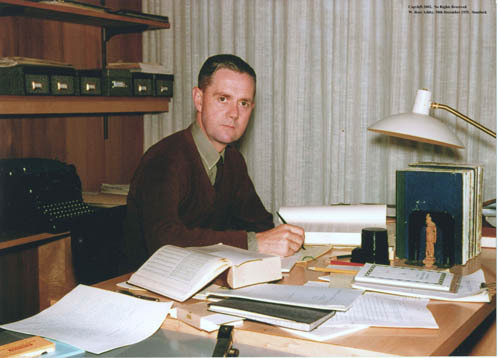Ross Ashby's other card index
During the Twentieth Century many thinkers used index cards to help them both think and write.
British cyberneticist Ross Ashby kept his notes in 25 journals (a total of 7,189 pages) for which he devised an extensive card index of more than 1,600 cards.
At first it looks as though Ashby used these notebooks to aid the development of his thought, and the card index merely catalogued the contents. But it turns out he used his card index not only to catalogue but also to develop the ideas for a book he was writing.

In a journal entry of 20 October 1943 he explained his decision to switch from an alphabetical key-word index to ‘an index depending on meaning’.
He describes his method as follows:
“20 Oct ‘43 - Having seen how well the index of p.1448 works, & how well everything drops into its natural place, I am no longer keeping the card index which I have kept almost since the beginning. The index was most useful in the days when I was just amassing scraps & when nothing fitted or joined on to anything else; but now that all the points form a closely knit & jointed structure, an index depending on meaning is more natural than one depending on the alphabet. So I have changed to a (card) index with the points of p.1448 in order. Thus it can grow, & be rearranged, on the basis of meaning. Summary: Reasons for changing the form of the index.” - Ross Ashby, Journal, Vol. 7
What was he up to? Thanks to Ashby’s meticulous note-taking, and the fact that it has all been saved and digitized, you can trace his working methods. It also helps that his handwriting is very clear!
- First Ashby made almost random notes in his notebooks, which he indexed alphabetically by key-word, using a card index. To aid referencing, he gave the notebooks a continuous page numbering across all 25 volumes.
- Next, in April 1943 and based on his notes, he created an outline for a book manuscript p.1234, then revised it six months later, on October 4th p.1447.
- Satisfied with the revised outline p.1497, he created a completely new card index (the ‘Other’ index), arranged by subject, based on the outline headings, rather than key-words. This new index is what he describes in his note of October 20th 1943, which is reproduced above.
- He deliberately kept this second index flexible, so that his notes could be re-arranged for as long as possible prior to the drafting of the actual manuscript.
This workflow is quite different from that of sociologist Niklas Luhmann, who unlike Ashby, didn’t use notebooks to any great extent. In fact it highlights a particularly striking aspect of Luhmann’s approach: for Luhmann the card index is its own contents; they are one and the same. Put another way, Luhmann’s Zettelkasten is largely self-indexing.
Ashby didn’t do this. Instead he followed the more standard card index system, elaborated, for example, by R.B. Byles, in 1911. In this system, originally designed for business, all documents are filed away, typically in order of receipt or creation, and then accessed by means of a separate card index, which provides the key to the entire collection. Ashby’s innovation was to adapt the card index system to refer to key-words in his notebooks, referenced by page number. Luhmann, certainly, also used key-words. His first Zettelkasten had “a keyword index with roughly 1,250 entries”, while his second, larger Zettelkasten had “a keyword index with 3,200 entries, as well as a short (and incomplete) index of persons containing 300 names” (Schmidt, 2016: 292).
However, due to Luhmann’s meticulous cross-referencing of individual cards, the key-word index isn’t strictly essential to connect the ideas in the Zettelkasten in a meaningful way; Luhmann’s cards link directly to other cards.
Fast-forward two generations and it seems that in the Internet age it is Luhmann’s method that has won out. The online version of Ross Ashby’s journal includes both the notebooks and the index as a single hyperlinked body of work. This represents a tremendous effort on the part of those who have painstakingly digitized the collection. Today, like Luhmann’s Zettelkasten, Ashby’s notebooks, at least in their Web-based incarnation, are finally self-indexing.
And there’s another sense in which Luhmann’s method won out. While Luhmann published scores of books, Ashby published plenty of academic articles, but only two full-length books. And neither of these books, as far as is evident, bear much relation to the manuscript outlines in his ‘other’ index. We can only speculate on whether Ashby might have produced more books had he used a system more like Luhmann’s.
Yet despite their differences, Ashby’s approach in creating his ‘other’ index is very consistent with Luhmann’s concern to keep the order of notes as flexible as possible for as long as possible.

References
The W. Ross Ashby Digital Archive
Jill Ashby (2009) W. Ross Ashby: a biographical essay, International Journal of General Systems, 38:2, 103-110, DOI: 10.1080/03081070802643402 (This is the source of the photo, above, of Ashby at his desk).
Byles, R.B. 1911. The card index system; its principles, uses, operation, and component parts. London, Sir I. Pitman & Sons, Ltd.
F. Heylighen, C. Joslyn and V. Turchin (editors): Principia Cybernetica Web (Principia Cybernetica, Brussels), URL: cleamc11.vub.ac.be/ASHBBOOK….
Schmidt, J. (2016). Niklas Luhmann’s Card Index: Thinking Tool, Communication Partner, Publication Machine. pdfs.semanticscholar.org/88f8/fa9d…)
*Read more *:
The Hashtags of a cyberneticist
Even the index is just another note
To illustrate that claim, here’s a dynamic index of my Zettelkasten articles